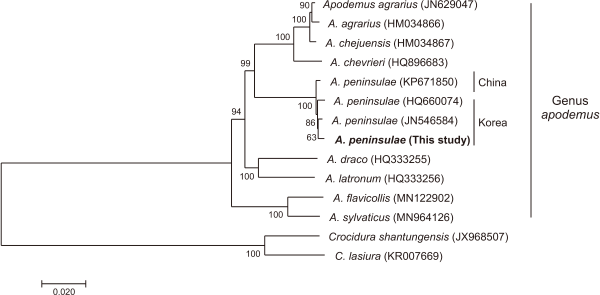Introduction
The genus Apodemus contains at least 20 rodent species (Musser & Carleton, 2005), of which only three have been recorded in South Korea, according to the National Institute of Biological Resources, and they are as follows: Apodemus agrarius, A. chejuensis, and A. peninsulae (Won & Smith, 1999; Yoon et al., 2004). The Korean field mouse, A. peninsulae is distributed from the Russian Far East and Japan (Hokkaido) to China and the Korean mainland (Batsaikhan et al., 2016; Jo et al., 2018). The habitats of these mice include fallow fields, grasslands, shrubs, and mixed forests (Lu & Zhang, 2005), but understory coverage and an abundance of fallen trees are significantly more important for forest-dwelling mice when compared to the striped field mouse (Lee et al., 2008; 2012). To date, the mitochondrial genome data for A. peninsulae has been reported for two inland samples from Korea and one from China (Jeon et al., 2016; Kim & Park, 2011; Oh et al., 2011).
Baengnyeong Island (BI) is located in the northernmost part of the West Sea on the Korean Peninsula, approximately 228 km from Incheon (Fig. 1). It has an area of 45.8 km2, a coastline road of 56.8 km, and it was connected to the Ongjin Peninsula in Hwanghae-do during the Quaternary Ice Age (Park & Lee, 2007). Despite its small area, BI is home to a variety of vertebrates such as birds, mammals, and amphibians, some of which are rare species that are not found inland (Kang et al., 2012; Park et al., 2019). The geographical location, topography, and climatic factors of BI and its complex biogeographic history indicate that it is an area with a high possibility for speciation (Cho et al., 2013).
In this study, the complete mitochondrial genome sequence from an A. Peninsulae specimen from BI in Korea was obtained for the first time. Furthermore the phylogenetic relationships between the genus Apodomus and the Korean and Chinese A. peninsulae were investigated This study verified the evolutionary status of A. peninsulae at the molecular level and provided important complementary data for its genetic background.
Materials and Methods
Tissue (muscle) samples from an A. peninsulae specimen (obtained at 37°58ʹ25.85ʺ, 124°41ʹ57.49ʺ; Ongjin-gun, Incheon, Korea; voucher number NIBRMM0000106403) were collected and stored in the National Institute of Biological Resources (NIBR, Inchoen, Korea). Sample collection was approved by the Institutional Animal Care and Use Committee (approval number: NIBR IACUC 20220001). Genomic DNA was extracted from the tissues using a DNeasy Blood and Tissue Kit (Qiagen) in accordance with the manufacturer’s protocol and deposited in the NIBR. DNA Link (Seoul, Korea) was used to perform whole-genome resequencing on an Illumina HiSeq 2500 platform. The mitochondrial genome was assembled using MitoZ (v.2.3) (Meng et al., 2019) and small gaps in the assembly were re-mapped using MITOBim (v.1.9.1) (Hahn et al., 2013). DOGMA (Wyman et al., 2004) and ARWEN (Laslett & Canback, 2008) were used for gene prediction. The neighbor-joining method was used to construct a tree with the software MEGA 6.0 (Arizona State University) using the Kimura 2-parameter model with 1,000 bootstrap replicates.
Results and Discussion
The total length of the A. peninsulae (GenBank accession: OL978460) mitochondrial genome was determined to be 16,268 bp with a GC base composition of 34.7%. The two mitochondrial genomes previously identified from inland South Korea samples were determined to be 16,269 bp (JN546584; Kim & Park, 2011) and 16,266 bp (HQ660074; Oh et al., 2011), while the sample from China was 16,457 bp (Jeon et al., 2016). There were one or two base pair differences with the Korean samples and a 189 bp difference with the Chinese sample. The mitochondrial genome was comprised of 13 protein-coding genes (PCGs), 22 transfer RNAs, two ribosomal RNAs, and a control region. The most common start codon, ATG, was found in nine of the PCGs, but not in the other four [ND1, ND3, ND5 (ATA), and ND2 (ATC)].
A neighbor-joining tree was constructed with the 13 PCGs sequenced here, along with 11 Apodemus mitochondrial genomes downloaded from GenBank (Fig. 2). Phylogenetic analysis confirmed that the clade of A. peninsulae was a sister to A. agrarius and A. chejuensis, which corresponded to the three species of the Apodemus genus recorded in South Korea. The three domestic A. peninsulae species, including individuals from BI, were grouped closer to each other than the Chinese A. peninsulae. In conclusion, this study enriches our evolutionary and ecological understanding of A. peninsulae through the contribution of mitochondrial genome data from an isolated region.

